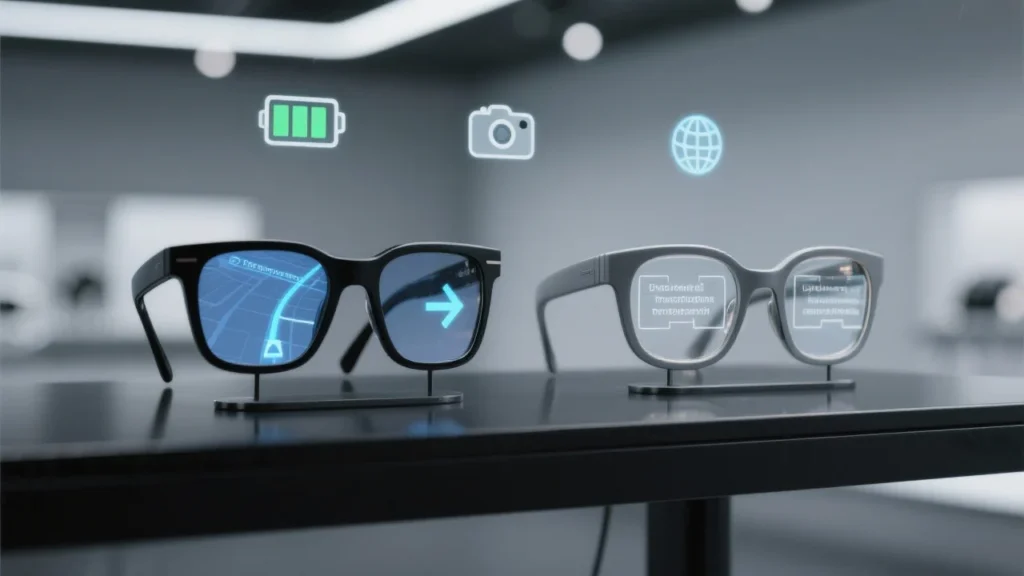The smart glasses market is experiencing an unprecedented surge. New players are challenging Meta’s dominance with innovative features and competitive pricing. The race for your face has officially begun, and the competition is fiercer than anyone expected.

Rokid Glasses: The Unexpected Challenger That’s Shaking Up the Market
Chinese company Rokid just pulled off something remarkable that has the entire tech industry talking. Their new AI glasses raised over $1 million in pre-orders within just three days of launching their Kickstarter campaign. That’s not a typo. Three days. In an era where crowdfunding campaigns often struggle to reach modest goals, Rokid’s success signals something significant about consumer appetite for smart glasses alternatives.
The Rokid Glasses aren’t just another tech gadget trying to ride the smart glasses wave. They’re a serious competitor that combines the best features of Meta Ray-Bans with next-generation upgrades that address real user pain points. Think convenient photography, earbud-like audio, and quick-access AI assistant but with a heads-up display that actually works without compromising your vision.
What makes these glasses genuinely special? The feature list reads like a wish list for smart glasses enthusiasts. They support 89 languages compared to Meta’s measly four. They shoot photos in both horizontal and vertical modes, giving users actual flexibility in how they capture moments. The battery is significantly bigger at 210 mAh versus Meta’s 154 mAh, promising longer usage between charges. Plus, they come with native ChatGPT support instead of Meta’s proprietary Llama AI model, and an Audio Memo feature for quick notes and reminders that busy professionals will love.
The engineering achievement here is impressive. Despite packing all this technology, they weigh exactly the same as Meta Ray-Bans at 49 grams. Same physical footprint as the flagship Wayfarer style, but with dramatically more capability. It’s like getting a smartphone upgrade while keeping the same form factor.
Rokid isn’t some startup operating out of a garage with big dreams and limited resources. The company has been building smart speakers and glasses since 2014, giving them a decade of experience in wearable technology. They’ve partnered with over 200 museums in China for immersive digital content, proving their technology works in real-world applications. At CES 2025, they were already giving demos of these glasses to industry professionals and journalists.
Liang Guan, Rokid’s US General Manager based in Redwood City, California, revealed that globally the company has received orders for over 300,000 units. Since the US Kickstarter campaign only accounts for about 1,900 orders, the vast majority of pre-orders are coming from partners and retailers worldwide. This suggests strong B2B interest alongside consumer enthusiasm.
Meta’s Hypernova: The Premium Response to Growing Competition
Meta isn’t sitting idle while competitors gain ground. The company is preparing to unveil its “Hypernova” smart glasses at the Meta Connect event on September 17. These aren’t your typical Ray-Ban Meta glasses they represent a significant leap forward in smart glasses technology.
Hypernova will feature a small color display in the right lens that users can see when looking downward. The display offers about a 20-degree field of view, appearing in a small window in a fixed position. Users will control it with a neural wristband that detects hand gestures and movements. The price tag? Around $800. That’s iPhone territory, reflecting the premium positioning Meta is pursuing.
But here’s the reality check that should temper expectations. Analyst Ming-Chi Kuo expects Meta to sell only 150,000 to 200,000 units over the next two years. For context, global smart glasses shipments are forecast to hit 14 million units next year. Hypernova’s market share will be negligible, positioning it more as an experimental product than a mass-market device.
Why such conservative expectations for a Meta product? The device faces several significant challenges. AI integration with augmented reality applications is still in its nascent stages. The estimated $800 price point limits the addressable market. The decision to use Liquid Crystal on Silicon microdisplay technology presents hardware design challenges related to form factor, brightness, response time, and battery life.
Kuo believes Meta’s real goals are strategic rather than commercial. The company wants to launch before Apple to build brand image. They need early experience developing the AR ecosystem. Understanding user behavior with display-equipped glasses will inform future product development.
The Neural Wristband Revolution: Reading Your Mind Through Your Muscles
The most intriguing aspect of Meta’s Hypernova isn’t the glasses themselves. It’s the accompanying wristband that represents a breakthrough in human-computer interaction. This device uses electromyography (EMG) to detect hand gestures and movements by reading electrical signals from your muscles.
This technology comes from CTRL Labs, which Meta acquired in 2019 for its expertise in neural interfaces. Instead of using camera sensors like Apple’s Vision Pro headset, the wristband interprets the electrical signals that your brain sends to your hand muscles. It’s like having a mind-reading device on your wrist, but it’s actually reading the electrical activity in your arm.
The concept is revolutionary, but the execution faces real-world challenges that highlight how difficult it is to create seamless human-computer interfaces. If the wristband is too loose, it can’t read electrical signals properly, impacting performance. Testing revealed issues related to which arm it’s worn on, differences in signal patterns between men and women, and problems when people wear long sleeves that interfere with signal detection.
Meta’s research team published a paper in Nature journal in July detailing their use of machine learning technology to make the wristband work with as many people as possible. The additional data collected from Hypernova users will improve these capabilities for future Meta smart glasses, making the current device as much a data collection tool as a consumer product.
The Pricing Battle: Finding the Sweet Spot for Mass Adoption
Smart glasses pricing reveals each company’s strategy and target market. The landscape is surprisingly diverse, reflecting different approaches to market penetration and feature positioning.
Meta Ray-Bans cost $299 to $379, targeting mainstream consumers who want basic smart glasses functionality. The new Meta Oakley glasses run $399 to $499, appealing to athletes and fitness enthusiasts. Rokid Glasses will retail for $599, but early Kickstarter backers get them for $479 with a 20% discount. Meta’s Hypernova at $800 sits at the premium end, competing with high-end smartphones.
The pricing strategy reveals fundamental differences in market approach. Meta’s Ray-Bans prioritize volume and mainstream adoption. Rokid targets tech early adopters who value features over brand recognition. Hypernova represents Meta’s premium experiment, testing whether consumers will pay smartphone prices for advanced smart glasses.
Meta’s decision to reduce Hypernova’s price from earlier estimates of $1,000 to $1,400 shows the company is accepting lower profit margins to boost demand. This aggressive pricing strategy suggests Meta views market share and user adoption as more important than immediate profitability.
Features That Actually Matter to Real Users

The smart glasses market is fragmenting based on feature sets that address different user needs and use cases. Basic audio-only glasses serve communication and entertainment purposes. Glasses with displays add information overlay capabilities. Full AR glasses promise immersive experiences but remain expensive and bulky.
Rokid Glasses offer practical advantages that address real user pain points. The magnetized pop-in lenses make customization and prescription lens changes easy a significant improvement over traditional lens systems. Turn-by-turn navigation helps with daily commutes and travel. Support for 89 languages opens global markets and makes the device useful for international travelers. The Audio Memo feature addresses a genuine need for quick note-taking and voice reminders.
Meta’s approach focuses on ecosystem integration and controlled user experience. Hypernova will run a specialized Android version with pre-installed apps but no app store access. Users won’t be able to install regular Android apps. It’s a controlled experience designed to work seamlessly with Meta’s services while preventing the fragmentation that could hurt user experience.
The display technology differs significantly between approaches. Rokid uses traditional heads-up display technology similar to what you’d find in AR glasses like the Even Realities G1. Meta employs Liquid Crystal on Silicon microdisplay technology for better scalability in mass production, but this choice creates hardware challenges related to brightness, response time, and battery life.
Market Dynamics and the Growing Competition Landscape
The smart glasses market is heating up beyond just Meta and Rokid. Samsung is reportedly preparing to reveal AI smart glasses on September 29, adding another major player to the mix. Google is working on its own smart glasses project, leveraging its AI expertise and Android ecosystem. Apple remains conspicuously absent from public announcements but is likely developing something significant behind the scenes.
EssilorLuxottica, the maker of Ray-Ban frames and Meta’s key partner, is scaling up production dramatically. CEO Francesco Milleri said the company is preparing to sell 10 million units annually by the end of 2026. That’s massive growth from the current 2 million pairs sold since 2023, indicating strong confidence in market demand.
The partnership between Meta and EssilorLuxottica has expanded significantly beyond simple manufacturing. Meta now owns about 3% of the glasses company and has exclusive rights to Luxottica’s brands for smart glasses technology. This strategic relationship gives Meta significant advantages in design, manufacturing, and retail distribution.
Different companies are pursuing different market segments. Meta focuses on social media integration and content creation. Rokid emphasizes practical productivity features and global language support. Samsung will likely integrate with its Galaxy ecosystem. Google will probably leverage its search and AI capabilities.
Technical Challenges That Define the Industry
Smart glasses face fundamental technical hurdles that constrain current capabilities and define future development priorities. Battery life remains severely limited due to size constraints and power-hungry components. Display brightness needs significant improvement for outdoor visibility. Form factor constraints limit component choices and thermal management options. Heat dissipation is particularly challenging in such a small device worn close to the user’s face.
The neural wristband technology is promising but still immature. Reading electrical signals from muscle movements requires precise calibration that varies between individuals. Anatomical differences affect signal quality and interpretation accuracy. Environmental factors like humidity, temperature, and electromagnetic interference can disrupt signal detection.
AI integration presents another layer of complexity. Current AI models require significant processing power that’s difficult to fit into glasses-sized devices. Edge computing helps reduce latency but limits functionality compared to cloud-based processing. Reliable internet connectivity becomes essential but creates dependency on network availability and quality.
Manufacturing at scale introduces additional challenges. Yield rates for complex microdisplays remain low. Quality control for neural interface technology requires new testing protocols. Supply chain management becomes more complex with specialized components from multiple suppliers.
Consumer Adoption Patterns and Market Reality
Early adopters are driving initial demand, but their preferences may not reflect mainstream consumer needs. Tech enthusiasts want the latest features regardless of price or practical limitations. They’re willing to accept experimental technology and provide feedback for future improvements. But mainstream adoption requires different value propositions focused on reliability, simplicity, and clear benefits.
Rokid’s success on Kickstarter shows strong interest from early adopters willing to pay premium prices for advanced features. The 20% discount attracted initial buyers, but the underlying technology and feature set impressed them enough to commit significant money. Support for multiple languages and practical features like navigation appeal to global users and business travelers.
Meta’s conservative shipment forecasts for Hypernova reflect realistic expectations about market readiness. Premium pricing at $800 limits the addressable market to affluent early adopters. Experimental features may not appeal to mainstream consumers who prioritize proven functionality over cutting-edge capabilities. The company is clearly building for the future rather than immediate mass adoption.
The success of Meta Ray-Bans at 2 million units sold demonstrates that consumers will adopt smart glasses when the value proposition is clear and the price is reasonable. Audio-only functionality, social media integration, and familiar Ray-Ban styling created a winning combination for mainstream users.
Investment Implications and Market Outlook
Meta has invested nearly $70 billion in its Reality Labs division since late 2020, representing one of the largest bets on future computing platforms in tech history. The company needs smart glasses to succeed commercially to justify these massive investments and prove the viability of its metaverse strategy.
Rokid’s rapid fundraising success demonstrates growing investor confidence in smart glasses alternatives to Meta’s offerings. The company’s global pre-orders of 300,000 units show real market demand exists beyond early adopter enthusiasm. Different regional features like wireless payments in China and navigation in the US reveal how companies are adapting to localized market needs and regulatory requirements.
The smart glasses market is projected to grow exponentially over the next few years. Current estimates suggest 14 million units shipped globally in 2026, up from minimal volumes today. Early movers have significant advantages in establishing market position, building developer ecosystems, and creating consumer brand recognition.
Investment in the space is accelerating beyond just Meta. Chinese companies like Rokid are attracting significant funding. Traditional eyewear companies are partnering with tech firms. Component suppliers are developing specialized hardware for smart glasses applications.
The Path Forward: What Success Looks Like

The smart glasses revolution is just beginning, but the path to mainstream adoption is becoming clearer. Meta Ray-Bans proved the market exists for basic smart glasses functionality. Rokid Glasses show that alternatives can succeed with superior features and competitive pricing. Meta’s Hypernova demonstrates the possibilities of premium smart glasses with advanced capabilities.
Success in this market will require balancing innovation with practicality. Companies must offer compelling features at reasonable prices while building ecosystems that work seamlessly across devices and services. They must address privacy concerns transparently and build consumer trust in wearable technology that can record and analyze personal behavior.
The companies that win will understand that smart glasses represent a fundamental shift in human-computer interaction. Instead of looking down at phones, we’ll look through glasses. And Instead of typing on keyboards, Also we’ll speak and gesture naturally. Instead of carrying multiple devices, we’ll wear integrated technology that enhances rather than distracts from real-world experiences.
One thing is certain: the future of computing is moving from our pockets to our faces. The question isn’t whether smart glasses will succeed it’s which company will lead the way and define how we interact with technology for the next decade.
Sources
- ZDNet: Look out, Meta Ray-Bans! These AI glasses just raised over $1M in pre-orders in 3 days
- Digital Trends: Meta’s ‘Hypernova’ AI smart specs will be an ‘experimental’ device
- Ubergizmo: Meta To Launch Affordable AR Glasses In September
- Seeking Alpha: Meta to introduce new smart glasses with display










Comments 1